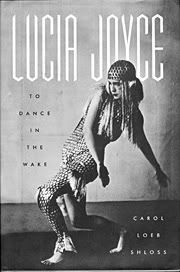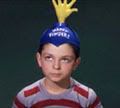Joyce And Sorrows

It was published in 2003, but I’m only now catching up to Carol Shloss’s biography of James Joyce’s daughter Lucia, To Dance In The Wake.
One could be forgiven, perhaps, for wanting to skip it after biographies of Joyce’s father and wife have appeared. What more could there be to say? And isn’t it common knowledge that Lucia was a hopeless schizophrenic who lived out her life in asylums?
The remarkable and radical thing about Shloss’s book is that it refuses to accept the critical commonplaces of Joyce scholarship and asks, “What if Lucia was not mentally ill?” Indeed, Shloss provides testimony from what seems like an endless line of witnesses who all agree that Lucia was, in fact, a lively and vivacious girl who seemed to have an artistic gift she’d inherited from her father.
It was a gift she channeled into modern dance and she received her first lessons from Isadora Duncan’s brother Raymond. Those who witnessed her performances saw great promise in her and an interviewer in 1928 remarked that “when she reaches her full capacity for rhythmic dancing, James Joyce may yet be known as his daughter’s father.”
Of course, part of the problem was the exact opposite: Joyce’s overwhelming fame and the amount of time he spent on Finnegans Wake conspired to make his children feel as if they were engaged in a sort of “sibling rivalry,” in Shloss’s words, with a book. His son Giorgio went on to lead a sad and dissipated life. Lucia was involved with a crowd of Parisian bohemians that seemed to inspire her creativity. Eventually, however, she seemed to become overwhelmed by a series of bad love affairs and other disappointments that sometimes left her catatonic or violent.
Was it the kind of behavior that merited confinement or observation? The well-meaning people that surrounded Joyce and his family were intent on protecting him from anything that might interfere with his writing, and so the view that Lucia was in need of medical care was heavily recommended. It was the dawn of the age of Psychiatry, a heavily patriarchal science in the beginning and Lucia, in retrospect, appears to have been sacrificed on the altar of it. “She was the price that had been paid for a book,” Shloss writes.
No two doctors could seem to agree on a diagnosis, though many felt she was merely “neurotic.” But the picture presented by Richard Ellmann’s bedrock biography of Joyce made it clear we were to think of her as damaged. Perhaps the most illuminating part of Shloss’s book is the opening section in which she follows the history of what did and didn’t find its way into Ellmann’s book and why. It's a sobering history that reminds you that scholarship sometimes compromises itself in order to keep its sources happy.
But if the idea that someone could be shuffled like paperwork into an asylum for being the daughter of a genius is too depressing to contemplate, it is tempered by the fact that her father never stopped trying to find the key that would unlock her mystery. Both seemed to sense that they shared a symbiotic relationship and it was Joyce who seemed to understand that Lucia’s confinement was only making her worse instead of better. When Shloss glosses the end of Finnegans Wake as a meditation on his relationship with the daughter he so dearly loved, it reads even more affectingly than we’d imagined.
It’s a necessary book and I have to say that, although she occasionally seems to try too hard to draw parallels that don’t seem to be there, I’m largely in sympathy with this portrait of an artist who struggled desperately beneath her father’s shadow. That Shloss was able to produce a biography at all is an achievement. So much of the record has been destroyed or expunged that there is very little to go on.
To Dance In The Wake does something that few works of Joycean scholarship do for me. It makes me see Joyce and his final masterwork differently and, my instinct says, more clearly than before. By serving the truth, surely it serves Joyce himself.













2 Comments:
Count! I've read of this very book and am intrigued further by your positive review.
One of the books packed in the beach-bag was a 1960-ish collection of Joyce's critical writings, edited by Richard Ellman and someone else -- beginning with an essay Joyce wrote at the age of 14! I had traded an Iris Murdoch novel for this little treasure clandestinely at a Christmas bookswap where we weren't supposed to do any pre-dinner trading. And I regret nothing!
Hmmm...have you read I Capture the Castle, which I view as sort of a 'what is like to be the child of a modernist writer' novel?
I know the collection well. The essay is "Trust Not Appearances," of which Ellmann says, "(it) may give heart to adolescents who are searching their own works for evidence of literary immortality, and not finding much." (JJ bio)
The 9-year old Joyce actually wrote a poem about Parnell that his father liked so well, he had copies printed up and distributed. He even claimed to have sent one to the Pope! No copies survive, though.
I do recommend the Lucia Joyce bio, though. Very informative and interesting.
Don't know I Capture The Castle, but sounds interesting. I'll look into it!
Post a Comment
<< Home